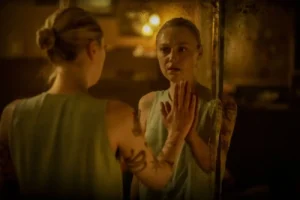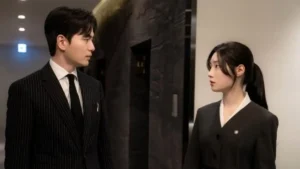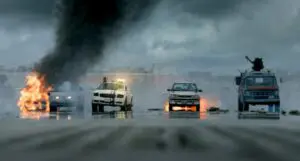Summary
The monstrosity of grindhouse meets the experimental nature of arthouse here, offering sensationalist B-movie style violence with an indie spin. The result of such a marriage makes Suspiria a heady, visual spectacle, but a patience-testing one with an insanely punishing runtime of 146 minutes.
It’s 1977, we’re in Berlin, and focused on meek but ambitious dancer Susie Bannion (Dakota Johnson). She enrols at the Helena Markos Dance Academy, a prestigious, all-girls school in Berlin run by its imposing artistic director and choreographer Madame Blanc (Tilda Swinton). Blanc grooms Susie to become her protégé, compelling her to perform in a dance piece called Volk. Across the film’s six acts, things get increasingly strange, and she finds herself enveloped by insidious darkness at the heart of the school.
Does this sound vaguely familiar? If so, that’s because Suspiria is a remake of Dario Argento’s critically-acclaimed 1977 cult horror of the same name. Now, the prospect of giving that masterpiece a do-over can’t have been fun. Hats off to a questionably insane Luca Guadagnino for having a good crack at it – probably after a few sleepless nights. Sadly, while he doesn’t try in vain to mold a straight reproduction of Argento’s creation, this is the most divisive film since Lars Von Trier’s The House that Jack Built last year. Not because it’s a re-make (they happen, so let’s just get over that) but because it doesn’t quite work as the original’s antithetical sibling.
The director of Call Me by Your Name, A Bigger Splash, and I Am Love is known for his bewitching, emotionally-charged, and technically proficient films, which are often bursting with light and color. Here, he steps out of his comfort zone, nodding to Argento’s work but putting his own muted stamp on it. He takes a distinctively banging, highly stylised, and vibrantly colored film, reworking it into a mystifying, visually cold and bleak tale of almost tangible malevolence. The outcome is far less garish and extravagantly violent than its predecessor, lacking its crassness but just as unsettling – unfortunately, not necessarily in the way we want a horror movie to disturb us.
David Kajganich’s screenplay may share similarities with the original, but the rest couldn’t be more juxtaposed. All in, it’s not as brilliant as its big brother, quickly becoming apparent that Guadagnino’s message is at sixes and sevens with the film’s crimson-tainted eleganza. We can see a heap of subtext exists within its walls, but what exactly does it say? Your guess is as good as mine.
Some poor attempts are made to tap into the politics of the time, some less subtle references to the dangers of 1977 Germany than others. The Berlin Wall sitting smack-bang opposite the school is one of the more obvious. This endeavor to give the story a historical backdrop is exasperating and serves no real purpose but to pad out a relatively vacant narrative.
Prudent casting decisions help to prop up Suspiria. Swinton brings her usual stunning brand of chilly weirdness and intensity, picking up more than one role and demonstrating once again what a versatile master of her craft she is. Johnson is an unexpected pick, but she manages to loosen her 50 Shades fetters and rise to the occasion.
The monstrosity of grindhouse meets the experimental nature of arthouse here, offering sensationalist B-movie style violence with an indie spin. The result of such a marriage makes Suspiria a heady, visual spectacle, but a patience-testing one with an insanely punishing runtime of 146 minutes (as compared with Argento’s 98-minute effort). Admiration all round to Guadagnino for fulfilling a long-running ambition, but sadly a sparse story and failure to build suspense may leave some viewers trailing off before the end. If you hack it, well done, but be sure to hang on for a post-credits stinger you won’t want to miss.



